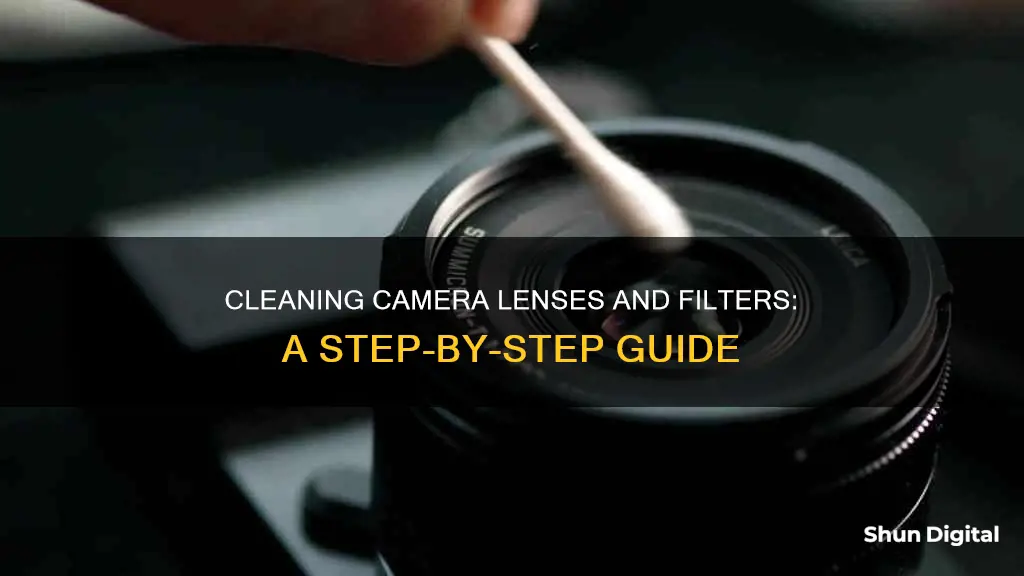
Keeping your camera lenses and filters clean is essential for maintaining image quality and the lifespan of your equipment. Dirty optics can affect image quality, and while there are correct and incorrect methods and tools for cleaning, the process is straightforward. This article will outline the steps for cleaning your camera lenses and filters, as well as some dos and don'ts to keep in mind.
| Characteristics | Values |
|---|---|
| Step 1 | Use a blower to remove dust |
| Step 2 | Use a lens brush |
| Step 3 | Use a lens cleaning solution |
| Step 4 | Use a cloth or tissue |
| Additional tools | Microfiber cloth, lens pen, air blower, soft brush, lens cleaning tissues |
| Don'ts | Harsh cleaning materials, spraying cleaning solution directly onto the lens, cleaning without blowing away dust, breathing on the lens |
What You'll Learn

Use a blower to remove dust
To clean your camera lenses and filters, you should always start by blowing off dust with a rocket blower. This minimises contact with the lens and reduces the risk of scratching the glass.
Before using the blower, give it a few puffs away from the lens to clear out any dust it may have gathered internally. Then, hold it as close as possible to the lens to avoid blowing dust in the air between the blower and the lens.
Always store your blower in a plastic bag to avoid it accumulating dust that might be transferred to the lens when you use it.
If there is still debris on your lens after using the blower, move on to a soft-bristled brush. Avoid touching the bristles with your fingers, and gently brush across the lens surface using your wrist to twist the brush back and forth.
If you are cleaning your lenses outdoors, a blower should always be in your camera bag so that you are ready for a quick clean.
Camera Lenses in China: Cheaper or Expensive?
You may want to see also

Use a lens brush
A lens brush is an essential tool to have in your camera cleaning kit. It is a great way to remove dust and other particles from your lens without causing any damage.
When choosing a lens brush, opt for one with camel hair bristles as they are thin and less likely to harm your lens. You can also find lens brushes with super-fine bristles that don't fall off the brush. Avoid touching the bristles with your fingers, especially if your hands are oily, to prevent leaving oily residues on the brush, which can then be transferred to your lens.
To use a lens brush, follow these steps:
- Ensure your lens is facing upwards.
- With gentle sweeping motions, brush away dust and debris from one side of the lens to the other.
- Be careful not to push down too hard on the brush, as a big piece of dust or debris could get stuck in the bristles and scratch your lens.
- You can also use the brush to clean the tight grooves around the edges of the lens.
By using a lens brush, you can effectively remove dust and particles from your camera lens, keeping it clean and well-maintained.
Camera Lenses: Is Price Tag Directly Linked to Quality?
You may want to see also

Use a lens cleaning solution
Using a lens cleaning solution is a great way to get your camera lens sparkling clean. However, it is important to be cautious when applying the solution to the lens.
Firstly, you should only use a lens cleaning solution if you have visible smudges, fingerprints, or oil on your lens. If your lens is only dusty, it is best to use a blower or brush to remove the dust.
If your lens does have visible smudges, you will need a lens cleaning solution and a lens cleaning tissue or cloth. Apply a few drops of the lens cleaning solution to the tissue or cloth. Do not apply the solution directly to the lens, as this could cause liquid to enter the lens body.
Once you have applied the solution to the tissue or cloth, use gentle, circular motions to wipe the lens, working from the centre outwards. This will help to prevent streaking.
Finally, use a dry, clean tissue or cloth to wipe away any remaining moisture on the lens.
Choosing a Lens Cleaning Solution
There are many different lens cleaning solutions on the market, so it is important to choose one that is compatible with your lens. Check the warning labels on the cleaning solution and your lens cleaning instructions to ensure that they are compatible. Some solutions may contain solvents or excessive amounts of alcohol, which could corrode the surface of your lens.
It is also important to avoid using household glass cleaners, such as Windex or bleach, as these can damage the lens coating. Instead, opt for a solution specifically designed for cleaning camera lenses.
If you want to make your own lens cleaning solution, you can mix equal parts 99% isopropyl alcohol and distilled water.
Other Tips for Using a Lens Cleaning Solution
- Always use a clean, dry tissue or cloth to wipe your lens. Reusing a dirty tissue or cloth will put dirt and grime back onto the lens.
- Be gentle when wiping the lens to avoid scratching the surface.
- Do not apply too much pressure, as this could lead to smudging.
- Wipe in concentric circles to reduce streaking.
- Work from the centre of the lens outwards to push debris towards the edge.
- If necessary, repeat the process to ensure streak-free glass.
- After cleaning, store your lens in a clean, sealed bag or container to keep it dust-free.
Understanding Camera Lenses: Power of Convergence and Divergence
You may want to see also

Use a cloth or tissue
When it comes to cleaning camera lenses and filters, using a cloth or tissue is an essential step. Here are some detailed instructions on how to use a cloth or tissue to clean your camera equipment effectively:
Choosing the Right Cloth or Tissue
- It is recommended to use a microfiber cloth or specific lens-cleaning tissues. Regular tissues should be avoided as they can scratch the lens.
- Microfiber cloths are reusable and washable. However, it is important to keep them clean to prevent transferring dirt and grime back onto the lens.
- Lens cleaning tissues are designed for one-time use only. They have a tight weave of fibres that don't fragment, reducing the risk of leaving fibres on the lens.
Preparing the Cloth or Tissue
- If using a microfiber cloth, apply a small amount of lens cleaning solution to the cloth. One or two drops are usually enough. Avoid using too much fluid as it may damage the camera's optics.
- For lens-cleaning tissues, pre-moistened wipes are available. Alternatively, you can apply a few drops of lens cleaning solution to the tissue.
Cleaning the Lens or Filter
- Before using the cloth or tissue, remove loose dust and debris from the lens using a blower or soft-bristled brush. This helps prevent scratching the lens while wiping.
- Starting from the centre of the lens, gently wipe in a circular motion towards the outer edges. Use gentle pressure to avoid damaging the lens coating.
- For stubborn stains or smudges, a lens pen with a soft cleaning tip can be used. Gently clean the affected areas without applying too much pressure.
- After cleaning, use a blower to remove any remaining particles or lint from the lens surface.
Additional Tips
- Always blow away dust or use a brush before wiping with a cloth or tissue. This prevents dust or dirt particles from scratching the lens.
- Do not spray cleaning solution directly onto the lens. Apply it to the cloth or tissue instead.
- Store your lens filters properly when not in use. Keep them in a protective case or soft bag to prevent dust and debris from settling on the surface.
Protect Your Camera Lens: Storage Tips for Photographers
You may want to see also

Avoid excess cleaning
While it is important to keep your camera lenses clean, it is also important not to overdo it. Here are some tips to avoid excess cleaning:
- Only clean your lenses when necessary. This could be when you notice any dirt, dust, smudges, or fingerprints on the lens.
- Use a lens blower or soft-bristled brush to remove dust and dirt particles from the lens before wiping it with a cleaning cloth. This will help prevent scratches on the lens.
- When using a cleaning cloth, be gentle and use a circular motion, starting from the outer part of the lens and moving towards the centre.
- Avoid touching the lens with your fingers, as natural oils from your skin can leave fingerprints and smudges.
- Store your lenses in a clean and dry place, such as a camera bag or pouch, when not in use.
- Always use lens caps to protect your lenses when they are not attached to the camera.
- Be cautious when using cleaning fluids, as too much fluid can damage the lens and its coatings. Only use a small amount, and avoid getting fluid inside the lens.
- If you are unsure about how to clean your lens, it is best to seek professional help rather than risk damaging your equipment.
Remember, while it is important to keep your lenses clean, excessive cleaning can do more harm than good. Follow the above tips to avoid overdoing it and keep your lenses in good condition.
How Eclipse Affects Camera Lenses and Photography
You may want to see also







